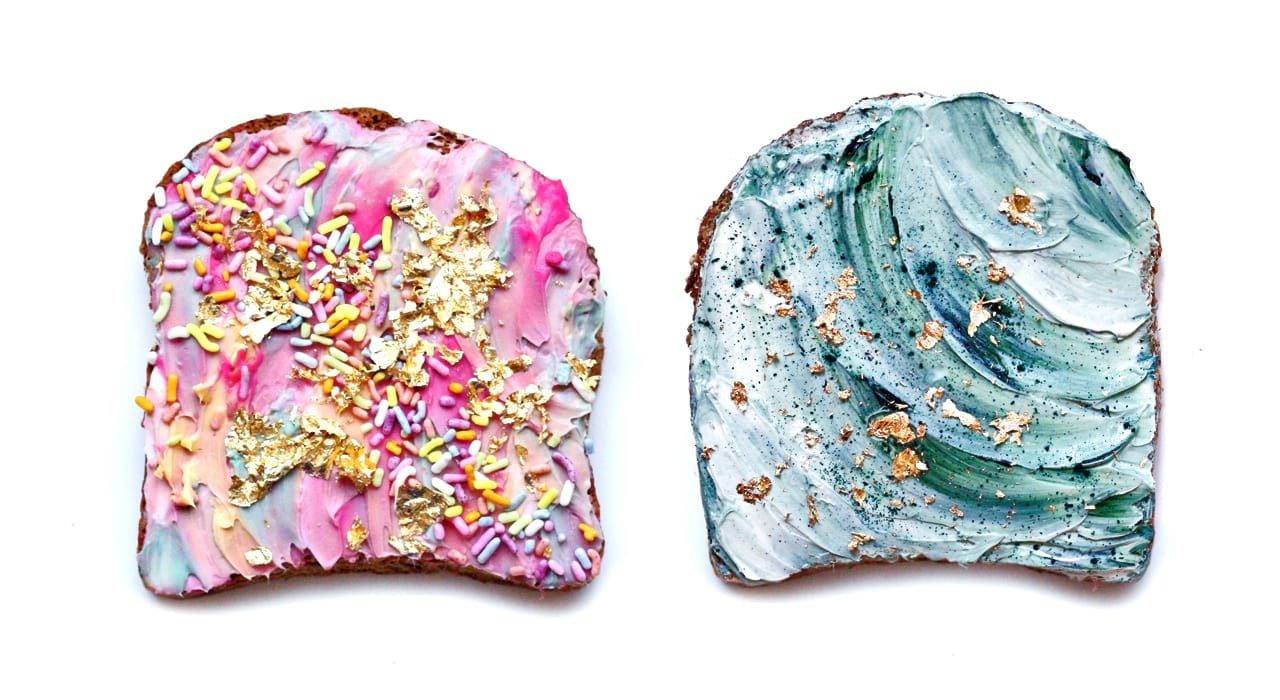By Harriet Mallinson | Published on April 25, 2017
It’s hard to ignore the unicorn food trend sweeping the web if you’re plugged into social media.
Reaching out to the inner kid inside of us, these vibrant, multicolored, multi-layered, glitter-covered, flower-encrusted confections look like the ultimate birthday party fantasy come true, be they in the form of macarons, cupcakes and rainbow-colored hot drinks or cookies, milkshakes and doughnuts.
The phenomenon first exploded onto the scene with unicorn toast, and later mermaid toast: the brainchild of 27-year-old Miami food stylist and photographer, Adeline Waugh. Instead of being content with plain old white cream cheese, Adeline jazzed up her breakfast by dying the cheese an exotic array of colors, spreading it artistically on bread and liberally adorning it with flamboyant sprinkles or flakes of edible gold.
“I had originally called unicorn toast, ‘watercolor toast,’†Adeline told TRAIN for HER. “I was just playing around with naturally colored cream cheese and creating cool looking brush strokes with my knife. The combination of pastels resembled ‘unicorn colors’, as my followers quickly pointed out.
“Unicorn toast is the combination of pink, purple, green, blue and orange. Mermaid toast is simply a combination of blues and greens that resemble the ocean.â€
Surely anything that looks so good has to be sinful, right? Well, Shona Wilkinson, Nutritionist at SuperfoodUK.com, comes bearing good news: the toppings are packed full of powerhouse ingredients mixed into almond milk cream cheese. Here’s Shona’s lowdown on the colors and the goodness within.
Blue: Algae
Blue-green algae gets its characteristic blue pigment from anti-oxidant phycocyanin, which protects our cells from harmful compounds and helps to keep us healthy.
The algae contains all essential and most non–essential amino acids which are the building blocks of proteins and support our hormones, enzymes, muscles, cell repair, rebuilding and neuron signalling in the brain.
It’s a very good choice for vegans and vegetarians who are often deficient in vitamin B12. Beta-carotene, also found in blue-green algae, has been shown to be higher than that found in carrots and broccoli. The body converts beta-carotene to Vitamin A, which contributes to the maintenance of healthy skin and vision.
Pink: Beetroot
Beetroot is packed full of natural nitrates, which are thought to increase blood flow to the brain, helping with focus and performance.
Yellow: Turmeric
Curcumin, which gives turmeric its yellow/orange colour, is packed with antioxidants. It has an anti-inflammatory effect and is often recommended for any health conditions caused by inflammation, such as rheumatoid arthritis and IBS.
You do need to take a lot per day to get the full effects, though. Add it to your food and consider taking it in supplement form.
– RELATED: 15 Ways To Enjoy Sweet Foods Guilt Free –
Green: Chlorophyll
Chlorella, which has a high chlorophyll content important for cleansing, has a balance of nutrients that cleanse, alkalize and protect the body with a special focus on supporting immunity. It is also high in chlorella growth factor, which is known to support the immune system.
Chlorella is one of the most nutritionally dense foods filled with antioxidants, amino acids, proteins, essential fatty acids, vitamins, minerals and nucleic acids. It can also help you to get rid of cellulite as it improves circulation as well as skin firmness and makes it more elastic.
Green: Spirulina powder
Spirulina is known to ward off free radicals and eliminate toxins from the skin. It has the ability to increase skin metabolism and therefore increase skin cell turnover and healing.
It is also often taken to help boost immunity as well as help prevent candida bacteria overgrowth, which can often cause acne breakouts. Spriulina is 65% protein (more than eggs) making it a great supplement for those who don’t get enough protein in their diet.
Red and purple: Strawberries and blueberries
Strawberries are very rich in Vitamin C. In fact, they can contain more than any other berry. Vitamin C acts as an antioxidant and supports the immune system, helping to protect the hair follicles. Like most berries, they contain a wide selection of antioxidant flavonoids and anthocyanins, which give your hair brilliant colour.
Some flavonoids in Blueberries may boost learning and memory and are thought to protect against oxidative stress (free radical damage) in the brain.
For more unlikely healthy foods, sign up to the MACROS newsletter.
Harriet is Editor of MACROS and perfectly capable of eating an entire log of goat’s cheese in one sitting.

